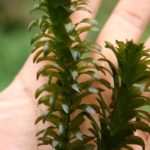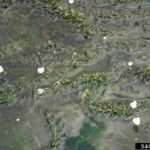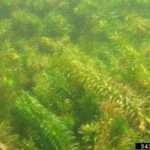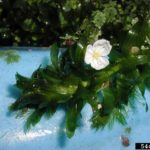Gallery:
- South American waterweed
- South American waterweed floating on the surface
- submerged South American waterweed
- South American waterweed flower
Common names:
South American waterweed, Brazilian elodea, common waterweed, Brazilian waterweed, dense waterweed, egeria, leafy elodea
Scientific Name:
Egeria densa
Description:
South American waterweed is a perennial aquatic plant in the Hydrocharitaceae (frogbit) family. It was introduced as a dumped aquarium plant and can be found all over western Oregon, especially along the coast. This leafy plant grows underwater in freshwater systems, and is sometimes free floating. The flowers bloom above the surface and are white with three petals. The leaves occur in whorls of 4 to 8 (mostly 4), are bright green, up to 1 inch long, and finely serrated. As only male plants have been found in the US, it doesn’t create seed; the primary reproduction method is through root and stem fragments, which easily break off and root elsewhere.
Life cycle:
Height of mature plants
Often 1-2 feet, but it can grow up to 10 feet
Flower color:
white
Bloom time:
July and August
Look-a-likes:
South Americam waterweed looks similar to American waterweed (E. canadensis) and hydrilla (Hydrilla verticillata). However, American waterweed is much smaller and less robust, generally has only 3 leaves per whorl, and leaves are usually less than 1 cm long. Hydrilla has 5 leaves per whorl, tiny spines along the leaf margins, and also produces tubers.
Habitat:
South American waterweed is an aquatic, submerged, freshwater plant, and thus it grows in lakes, ponds, quiet streams and ditches. It is usually rooted to the bottom in depths up to 8 feet, but is also often found in floating masses.
Impacts:
South American waterweed can grow quite thick in waterways, creating obstructions to boating, fishing and swimming. The thick mats of this weed can also impede water flow, clog water pumps, shade out other aquatic plants and degrade the water quality. As an aquatic plant that also spreads by root and stem fragments, it can be quite difficult to control.
Noxious Weed Listing:
- WeedWise: maintenance
- State of Oregon: Class B
- State of Washington: Class B
- Four County CWMA: Class C
- Columbia Gorge CWMA: Class B
Origin:
South America
Links:
Oregon Noxious Weed Profile
Washington Noxious Weed Profile
Invasive.org profile
CABI Invasive Species Compendium




